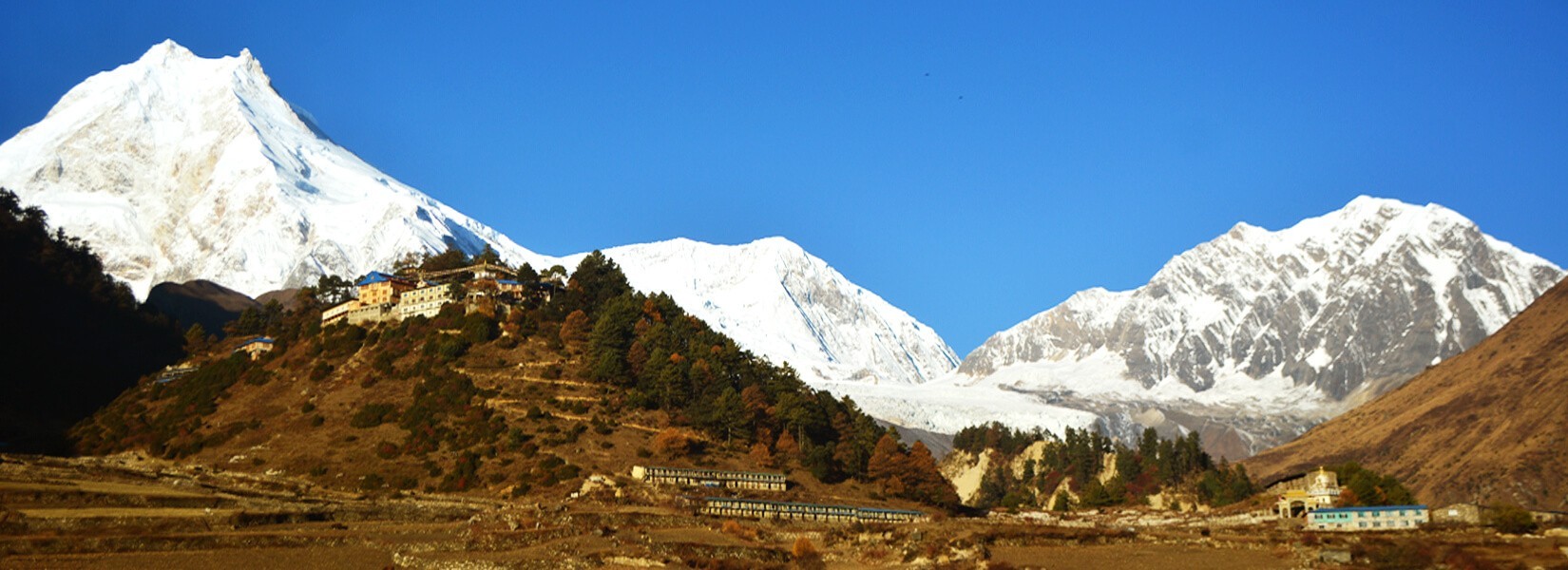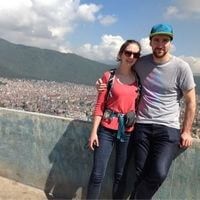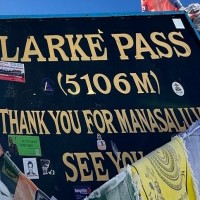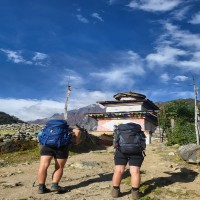The Manaslu Circuit Trek is one of the most beautiful and less crowded treks in Nepal. This trek takes you around Mount Manaslu (8,163m), the 8th highest mountain in the world. Manaslu circuit trek is known for its stunning landscapes, rich culture, and challenging trails.
Your journey for this wonderful trek starts from Soti Khola and ends at Besi Sahar. Over 12 days, you will pass through dense forests, deep valleys, remote villages, and high mountain passes. The highest point of the trek is Larkya La Pass (5,167m). This pass is usually covered in snow and offers breathtaking views of Manaslu, Annapurna, and Ganesh Himal.
Unlike the Everest Base Camp and Annapurna Circuit, the Manaslu region sees fewer trekkers. This makes the experience more peaceful and allows you to enjoy the untouched beauty of the Himalayas. However, it is also a restricted trekking area, meaning solo trekking is not allowed. You must trek in a group with a licensed guide and obtain special permits.
The Manaslu Circuit trek is not just about the mountains. You will also explore Tibetan-influenced villages, ancient monasteries, and Buddhist culture. Villages like Lho, Samagaun, and Samdo offer a chance to see prayer flags, chortens, and traditional lifestyles. The Manaslu Conservation Area is home to rare wildlife, rivers, waterfalls, and forests.
This trek is physically demanding. The trails include suspension bridges, rocky paths, and steep climbs. The altitude gain can make trekking difficult, so proper acclimatization is important. The toughest part is crossing Larkya La Pass, which requires starting early in the morning to avoid strong winds.
Despite the challenges, the Manaslu Circuit Trek is an unforgettable experience. It combines natural beauty, adventure, and cultural exploration. The journey through remote villages and breathtaking landscapes makes it one of the best trekking routes in Nepal.
- Destination: Nepal
- Trip Difficulty: Strenuous
- Trip Style: Trekking and Tour
- Transport: Tourist Bus
- Food: Breakfast+Lunch+Dinner
- Accommodation: 3-Star Hotel + Teahouses + Lodges
- Group Size: 02-15
- Max Elevation: 5,364m
Highlights
Manaslu Circuit Trek Highlights
• Stunning views of Mount Manaslu (8,163m), the 8th highest peak in the world.
• Breathtaking panoramas of Himlung Himal, Annapurna II, Ganesh Himal, and Lamjung Himal.
• Cross Larkya La Pass (5,167m), the highest and most challenging point of the trek.
• Trek through diverse landscapes, from subtropical forests to high-altitude tundra.
• Pass through the Budhi Gandaki River Valley, with deep gorges, waterfalls, and glacial rivers.
• Experience rich Tibetan-influenced culture in remote villages like Lho, Samagaun, and Samdo.
• Visit ancient monasteries, including Nubri Monastery and Pungyen Monastery.
• Explore suspension bridges, prayer flags, mani walls, and chortens along the trail.
• Hike to the Tibetan border from Samdo Village.
• Less crowded than Everest and Annapurna treks, offering a peaceful trekking experience.
• Challenging and adventurous trails, with steep climbs and rugged paths.
Outline Itinerary
Day 01Drive from Kathmandu to Maccha Khola (869 m) via Soti Khola
Day 02Machhakhola to Jagat(1410m) Duration: 6-7 hours
Day 03Jagat to Deng (1860m) 6-7 hours
Day 04Deng to Namrung (2,600m) 5-6 hours
Day 05Namrung to Samagaon (3540 m) .
Day 06Rest and acclimatization day.
Day 07Samagaon to Samdo (3,860m) 3-4 hours.
Day 08Samdo to Dharamsala 4,460m /Larke Base Camp.
Day 09Larke Base Camp to Larkya Pass (5,160m) to Bimthang .
Day 10Bimthang to Gho (2,515m/8,250ft) | 5-6 hours
Day 11Gho to Dharapani (1,920m/6,300ft) | 3-4 hours
Day 12Dharapani to Besi Sahar (760m/2,495ft) to Kathmandu (1,300m/4,264ft) | 9-10 hrs drive
What to Expect
What's included
- Kathmandu to Machi Khola by tourist bus.
- Besishar back kathmandu tourist bus.
- Full board meal during the trek (breakfast, lunch, and dinner).
- Teahouse accommodation on the trek.
- Seasonal fruits during the trek.
- Experienced, expert, friendly guide, porter and their food, accommodation, salary, equipment, and insurance.
- Duttle bag for the trekking use.
- First Aid kit included Oximeters.
- All permits and Tims (please bring a passport copy and photos).
- Government tax, farewell dinner.
What's not included
- International flight tickets.
- Travel insurance.
- Nepal entry visa.
- Cold drinks, snacks, and personal equipment.
- Tips for guide, porters and drivers.
Useful Information
Additional Information for Manaslu Circuit Trek
Best Time for Manaslu Circuit Trek
Choosing the right time for the Manaslu Circuit Trek is important for a safe and enjoyable experience. The weather, trail conditions, and overall trekking experience change with the seasons. Spring and autumn are the best seasons for this trek, offering stable weather, pleasant temperatures, and stunning mountain views.
Spring (March to May) is one of the best times for the Manaslu circuit trek. The temperature is mild, making trekking easier. The sky is usually clear, providing breathtaking views of the snow-capped peaks. The trails are filled with blooming rhododendrons and other wildflowers, making the journey more scenic. This season is also perfect for wildlife spotting as animals become more active after the winter.
Autumn (September to November) is another ideal season for the Manaslu Circuit Trek. After the monsoon season, the air becomes fresh and crisp. The trails are dry, and the skies remain clear, offering spectacular views of the Himalayan ranges. The weather is cool and stable, making trekking more comfortable. This season also brings festive vibes, as major Nepali festivals like Dashain and Tihar take place during this time.
Monsoon (June to August) is the least favorable time for the trek. Heavy rainfall makes the trails slippery and muddy. There is a high risk of landslides and leeches on the lower trails. Cloudy skies often block the mountain views. However, the landscape becomes lush and green, creating a different kind of beauty. Trekking during this season requires extra preparation and caution.
Winter (December to February) brings extreme cold and heavy snowfall. The Larke Pass, the highest point of the trek, is often blocked by snow, making it difficult and risky to cross. The temperatures drop below freezing, especially at higher altitudes. While the trek is still possible, only experienced trekkers should attempt it. If you enjoy snow-covered landscapes and solitude, winter trekking might be an option, but you need to be well-prepared for harsh conditions.
For the best experience, plan your Manaslu circuit trek in spring or autumn. These seasons offer perfect weather, safe trails, and breathtaking scenery. They ensure that your journey is memorable and enjoyable.
Permits for Manaslu Circuit Trek
The Manaslu Circuit Trek is in a restricted area, so trekkers must get special permits before starting their journey. Solo trekking in the Manaslu region is not allowed. You need to be in a group of at least two trekkers and hire a licensed guide. Also, permits can only be issued through a registered trekking agency in Nepal.
These permits help protect nature, wildlife, and local culture as well as assure that you’re safe on your adventure. They also ensure that tourism benefits the local communities. Before starting your trek, make sure you have all the necessary permits to avoid problems along the way.
Trekkers need three main permits to complete the Manaslu Circuit Trek.
Manaslu Restricted Area Permit (RAP): This is the most important permit. Since Manaslu is a restricted region, this permit allows trekkers to enter. The cost depends on the trekking season.
Manaslu Conservation Area Permit (MCAP): This permit is required because the trek goes through the Manaslu Conservation Area.
Annapurna Conservation Area Permit (ACAP): The last part of the Manaslu trek enters the Annapurna Conservation Area. Because of this, trekkers need an ACAP permit.
Chumnubri Rural Municipality Permit: This is a recently introduced local permit. The money collected from this permit supports conservation and sustainable tourism in the Manaslu region.
Additional Permits (If Needed)
• Tsum Valley Permit: If you plan to visit Tsum Valley, you must get this special permit.
• TIMS Card: If you want to extend your trek into the Annapurna region, a TIMS (Trekkers’ Information Management System) card may be required.
Getting these permits is only possible through a registered trekking agency. Trekkers must submit passport copies and passport-sized photos. Also, solo trekkers cannot get permits, so you must trek in a group with a licensed guide.
Food and Accommodation for the Manaslu Circuit Trek
During the Manaslu Circuit Trek, the food in the teahouses is simple but energizing. For breakfast, you can enjoy options like oats, pancakes, bread with eggs, and porridge. The morning meal will help prepare you for the long day ahead. For lunch and dinner, you will often eat dal bhat. This meal is very popular and provides the necessary energy for trekkers. Other meal options include noodles, momo (dumplings), fried rice, soup, pasta, pizza, and fried potatoes.
It is important to note that meals in these tea houses are usually served with hot drinks like tea, coffee, or garlic soup. You will have plenty of opportunities to try local specialties while interacting with the warm and friendly locals. You will also find snacks like protein bars, chocolates, and other energy foods are a good option to keep you going throughout the day.
Throughout the Manaslu Circuit Trek, you will mostly stay in tea houses or lodges. These accommodations are very basic but offer a comfortable and cozy resting place after a long day of trekking. You may want to bring a sleeping bag as the blankets might not be warm enough, especially at higher altitudes.
Shared toilets are common in these teahouses. You will also find common dining areas where trekkers can gather and enjoy their meals together. Heating is available only in the dining areas where a wood stove provides warmth.
During the trek, you will need to book your accommodations in advance if you are trekking during the peak season. This is important because the teahouses can fill up quickly. If the tea houses are full, you may have to share rooms with other trekkers. This is a perfect way to rest, share stories, and get ready for the next day of trekking.
Difficulties of the Manaslu Circuit Trek
The Manaslu Circuit Trek is a challenging adventure in the remote Himalayas. It takes you through rugged trails, high altitudes, and isolated villages. The trek is not easy, but with the right preparation, it is possible for anyone with basic fitness. Trekkers need to carry their gear throughout the journey. A heavy backpack can make the trek more difficult. Hiring a porter can reduce the burden and make the trek more comfortable.
The biggest challenge of this trek is the high altitude. The trail gradually rises above 5,000 meters, where the oxygen level decreases. This can cause altitude sickness, which brings headache, nausea, dizziness, and shortness of breath. Acclimatization is very important to avoid these problems. Trekkers should take slow steps, drink plenty of water, and avoid alcohol. If symptoms get worse, descending to a lower altitude is the best solution.
The trek lasts around 14 days, depending on the itinerary. Each day, trekkers walk for 6 to 7 hours on rough trails. The distance covered daily is about 8 to 12 km, which requires good stamina and endurance. The paths go through steep ascents, descents, and river crossings, making the journey even more demanding. Proper training before the trek helps reduce fatigue and muscle strain.
The Manaslu Circuit Trek is a moderate to difficult trek. It requires good fitness, mental preparation, and proper planning. Challenges like altitude, long trekking hours, and rough terrain make the trek demanding. However, with proper acclimatization, physical training, and a positive mindset, it is an unforgettable adventure.
Manaslu Circuit Trek Packing List
Packing the right gear is essential for a comfortable and safe trek. The weather in the Manaslu region can change quickly, so it's important to be well-prepared. Here's a straightforward packing list to guide you.
Clothing
• Base Layers – Lightweight and moisture-wicking thermal tops and bottoms.
• Insulating Layers – Fleece jackets or down jackets for warmth in high-altitude areas.
• Outer Layers – Waterproof and windproof jackets and pants for protection against rain, snow, and wind.
• Trekking Shirts – Breathable, moisture-wicking t-shirts (avoid cotton).
• Trekking Pants – Comfortable and durable pants for long hikes.
• Thermal Wear – Essential for cold nights and higher altitudes.
• Hat – A warm beanie or woolen hat for cold temperatures.
• Sun Hat – Protects against harsh sunlight.
• Gloves – Lightweight gloves for mild weather and insulated gloves for freezing temperatures.
• Buff or Neck Gaiter – Helps with dust, cold winds, and sun protection.
• Socks – Several pairs of wool or synthetic socks to keep feet warm and dry.
• Underwear – Quick-drying and breathable materials.
Footwear
• Trekking Boots – Sturdy, waterproof boots with good ankle support.
• Camp Shoes – Lightweight shoes or sandals for resting at teahouses.
• Gaiters (Optional) – Protect your boots from mud, snow, and small rocks.
Backpack and Accessories
• Trekking Backpack – A 40-60 liter backpack for carrying extra clothes and gear.
• Daypack – A small bag for daily essentials like water, snacks, and rain gear.
• Rain Cover – Protects your backpack from rain and dust.
• Dry Bags – Keep your clothes and electronics dry.
• Trekking Poles – Helps with balance and reduces strain on knees.
Sleeping Gear
• Sleeping Bag – A four-season sleeping bag rated for -10°C to -18°C.
• Sleeping Bag Liner – Adds extra warmth and keeps the sleeping bag clean.
• Sleeping Pad (Optional) – Useful for extra comfort in teahouses.
Personal Items
• Sunglasses – Protect your eyes from UV rays and snow glare.
• Headlamp – Useful for early morning hikes and power cuts in teahouses. Bring extra batteries.
• Water Bottles – Reusable bottles or a hydration system to stay hydrated.
• Water Purification – Tablets or a water filter to ensure safe drinking water.
• First-Aid Kit – Include bandages, blister treatment, pain relievers, and altitude sickness medicine.
• Toiletries – Toothbrush, toothpaste, biodegradable soap, wet wipes, and toilet paper.
• Sunscreen – High SPF protection for the strong mountain sun.
• Lip Balm – Prevents dry and chapped lips.
• Insect Repellent – Useful in lower altitude areas.
Documents and Money
• Permits – Manaslu Restricted Area Permit, Annapurna Conservation Area Permit (ACAP), and TIMS card.
• Passport – Carry both the original and a copy for emergencies.
• Travel Insurance – Must include emergency evacuation coverage.
• Cash – Enough Nepali Rupees for the entire trek, as ATMs are unavailable in the trekking region.
Optional Items
• Camera – To capture the stunning Himalayan landscapes.
• Power Bank – To charge electronic devices, as electricity is limited.
• Snacks – High-energy snacks like nuts, protein bars, and chocolate.
• Gaiters – Useful for keeping snow and debris out of boots.
• Earplugs – Helpful for sleeping in noisy teahouses.
Packing smart makes the Manaslu Circuit Trek more enjoyable. Carry only the essentials to keep your backpack light. The right gear will keep you warm, dry, and comfortable throughout the trek.
FAQs
What is the Manaslu Circuit Trek?
The Manaslu Circuit Trek is a challenging and remote trekking route that circles Mount Manaslu (8,163m), the eighth-highest peak in the world. This trek is an excellent alternative to the Annapurna Circuit for those seeking a more off-the-beaten-path experience.
How long does the Manaslu Circuit Trek take?
The trek usually takes 14–18 days, depending on the itinerary and acclimatization days. A standard itinerary includes gradual elevation gain and a crossing of Larke La Pass (5,106m), ensuring a safe and enjoyable experience.
How difficult is the Manaslu Circuit Trek?
The Manaslu circuit trek is considered moderately to highly difficult. It involves steep ascents, high-altitude trekking, and long daily walking hours (5-8 hours per day). Proper physical preparation and acclimatization are necessary.
What is the highest point of the Manaslu circuit trek?
The highest point of the Manaslu Circuit Trek is Larke La Pass (5,106m), which offers panoramic views of Manaslu, Himlung Himal, Cheo Himal, and Annapurna II. This pass is the most challenging part of the trek due to its altitude and weather conditions.
What are the best months for the Manaslu Circuit Trek?
The best months for the Manaslu Circuit Trek are March to May (spring) and September to November (autumn). These seasons offer stable weather, clear mountain views, and comfortable temperatures. Winter trekking is possible but extremely cold, while the monsoon season (June to August) brings heavy rainfall and difficult trail conditions.
Do I need special permits for the Manaslu Circuit Trek?
Yes, trekkers need five permits for the Manaslu Circuit Trek:
• Manaslu Restricted Area Permit (MRAP)
• Annapurna Conservation Area Permit (ACAP)
• Trekkers’ Information Management System (TIMS) card
These permits help regulate trekking in the restricted region and contribute to conservation efforts.
Can I trek the Manaslu Circuit without a guide?
No, you cannot trek the Manaslu Circuit without a guide. The Nepalese government requires trekkers to hire a licensed guide and be in a group of at least two for safety reasons and to protect the region's environment and local communities.
How much do the permits cost?
Permit costs vary based on the season:
Manaslu Restricted Area Permit:
• September to November: USD 100 per person for the first week, then USD 15 per additional day.
• December to August: USD 75 per person for the first week, then USD 10 per additional day.
• ACAP and TIMS: Around USD 30-40 combined.
What type of accommodation is available?
The Manaslu Circuit trek mainly offers teahouse accommodations, which are basic but comfortable lodges run by locals. Rooms are simple, with twin beds, blankets, and shared bathrooms. Some tea houses at lower altitudes have hot showers and Wi-Fi, but facilities become more basic at higher elevations.
What kind of food is available during the trek?
Teahouses provide a mix of Nepali and basic Western dishes. The staple food is Dal Bhat (rice, lentils, vegetables, and pickles), which provides energy for trekking. Other options include noodles, soups, momo (dumplings), porridge, eggs, and pancakes.
Is hot water and electricity available?
Yes, but availability depends on the altitude. In lower areas, hot water is available for an extra charge. At higher altitudes, hot showers may be bucket showers using heated water. Electricity is available for charging devices, but it may cost extra due to limited resources.
Is Wi-Fi or a mobile network available on the trek?
Wi-Fi is available in some tea houses for a small fee, but the connection is often slow and unreliable. Mobile networks like NCELL and NTC work in some lower areas but become weak or unavailable at higher altitudes. A satellite phone or local SIM card may help in emergencies.
How can I prevent altitude sickness on the Manaslu Circuit Trek?
To prevent altitude sickness you can follow these useful steps:
• Acclimatize properly by taking rest days at key points.
• Stay hydrated and drink plenty of water.
• Ascend gradually and avoid gaining more than 500m per day above 3,000m.
• Eat well and avoid alcohol at high altitudes.
• Consider medication like Diamox if recommended by a doctor.
What should I do if I get altitude sickness?
If symptoms like headaches, nausea, dizziness, or difficulty breathing appear, descend immediately to a lower altitude. Do not ignore the symptoms, as severe altitude sickness can be life-threatening. Seek medical help and use oxygen or medication if needed.
Is there a risk of landslides or avalanches?
Yes, there are some risks of landslides, especially in the monsoon season when heavy rainfall can cause landslides in the lower region. Avalanches may occur in winter or after heavy snowfall, particularly near Larke La Pass. Trekkers should check weather updates and follow the guide's instructions.
How do I get to the starting point of the trek?
The trek starts in Soti Khola, which is reached by a 7-9 hour drive from Kathmandu. A private jeep is the best option for comfort, while public buses are cheaper but less convenient.
What kind of culture and local people can I expect?
The Manaslu region is home to Tibetan-influenced communities, including the Gurung and Tamang people. Trekkers can explore ancient monasteries, prayer wheels, and Mani walls along the route. The people are warm and welcoming, offering insights into their Buddhist traditions and rural lifestyles.
Are there any festivals I can experience during the trek?
Yes, if trekking in autumn or spring, you may witness local festivals like Loshar (Tibetan New Year), Tihar (Festival of Lights), and Dashain. These festivals showcase traditional dances, prayers, and cultural celebrations in the villages.
How can I trek responsibly and support the local community?
Trekkers can be responsible by carrying reusable bottles, avoiding plastic waste, and respecting local customs. Supporting local teahouses and buying locally made products helps the community economically. Hiring licensed guides and porters ensures fair wages and ethical trekking practices.











